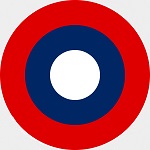Wings of the Great War WW11301 U.S. Air Service Salmson 2 A2 Reconnaissance Aircraft - Coyle, Corley and Easterbrook, 1st Aero Squadron, 1918 (1:72 Scale)
"Aviation is proof that given, the will, we have the capacity to achieve the impossible."
- Eddie Rickenbacker
 The Salmson 2, (given the military designation Salmson 2 A2) was a French biplane reconnaissance aircraft made by Salmson. It was developed to a 1916 requirement. Along with the Breguet 14, it was the main reconnaissance aircraft in use with the French army and the American Expeditionary Force's aviation units in 1918. At the end of the First World War, one-third of French reconnaissance aircraft were Salmson 2s.
The Salmson 2, (given the military designation Salmson 2 A2) was a French biplane reconnaissance aircraft made by Salmson. It was developed to a 1916 requirement. Along with the Breguet 14, it was the main reconnaissance aircraft in use with the French army and the American Expeditionary Force's aviation units in 1918. At the end of the First World War, one-third of French reconnaissance aircraft were Salmson 2s.
During the First World War, the Salmson factory built aircraft engines, generally 9- and later 18-cylinder water-cooled radial engines developed from the Swiss Canton-Unne design, one of the earliest known non-rotary radial engine designs ever used for military aircraft. The company's first entry into aircraft design came with the Salmson-Moineau S.M. 1, an unusual three-seat reconnaissance biplane with twin airscrews gear-driven from a single Salmson engine in the nose of the fuselage. These aircraft, of which 155 were built, were not especially successful.
The Salmson 2 developed from a requirement to replace the Sopwith 1-1/2 Strutter and Dorand A.R. reconnaissance aircraft in the A2 (tactical reconnaissance) role. Salmson had built the 1-1/2 Strutter under license, and the Salmson 2, while an original design, owed more to the Sopwith than to the earlier Salmson-Moineau. The aircraft was of conventional construction with a two-bay biplane configuration, powered by the company's own Salmson 9Z water-cooled radial engine of 230 bhp. Some minor control problems were quickly resolved in early testing, but the main defect of the Salmson 2, shared with the contemporary Airco DH.4, was that the pilot and gunner were seated rather far apart, making communication difficult. Production was ordered after trials on April 29th, 1917, and deliveries were underway by October of that year. Around 3,200 Salmson 2s were built in France, 2,200 by Salmson and the remainder by the Latecoere, Hanriot, and Desfontaines, companies. Some of these were Salmson 2 D.2 dual control advanced training aircraft.
Pictured here is a 1:72 scale replica of a US Air Service Salmson 2A2 Reconnaissance Aircraft that was attached to the 1st Aero Squadron during 1918.
Sold Out!
Dimensions:
Length: 4-1/4-inches
Wingspan: 6-1/2-inches
Release Date: December 2015
Historical Account: "Croix de Guerre" - On April 4th, 1918, the 1st Aero Squadron was assigned to the I Corps Observation Group, Air Service, First Army, and was designated as a Corps Observation Squadron. Movement was made to Ourches Aerodrome for combat duty. In combat, the mission of the 1st Aero Squadron was general surveillance of the enemy rear areas by means of both visual and photographic reconnaissance. These missions were carried out for the purpose of intelligence-gathering and informing First Army headquarters informed of enemy movements and preparations for attacks or retreats of its infantry forces. The 1st identified enemy activity along roads and railroads, ground stations, various storage dumps and airfields, the numbers of fires, and activities of enemy aircraft, and the amount of anti-aircraft artillery was also monitored and reported. Due to the nature of the missions and the depths of enemy area which was penetrated, the missions were carried out at high altitudes, usually between 4,500 and 5,500 meters (14,800 and 18,000 ft).
Bad weather and engine trouble with the SPAD aircraft plagued the squadron upon its arrival at the front, and on April 12th, the first contact with enemy aircraft was made, when Lt Coyle was attacked by three German planes. He escaped, his plane having several bullet holes. The work done by the squadron in its early days of combat operations was judged to be of high order. A great deal of valuable intelligence was obtained. This was recognized when French General Passage, Chief of Staff of the 32d French Corps, awarded the "Croix de guerre" to several aircrews for exceptional bravery in combat.





 Salmson
Salmson 


